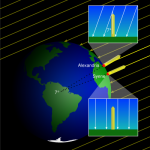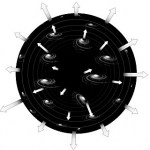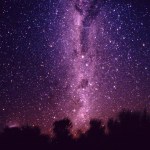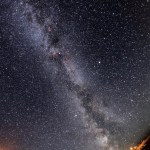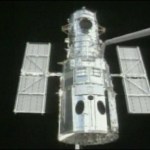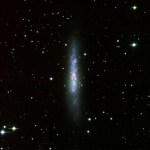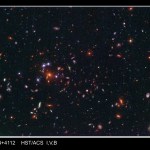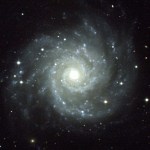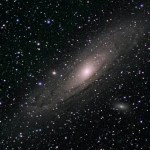Galaxies
We have a treat for you this week: Starts With A Bang gets to host this week's Carnival of Space! We take the best space and astronomy posts from around the internet and pull them together in one great extravaganza! I've gotten to host twice before, and this is a very special edition for astronomers. Why, you ask?
Yesterday was the Summer Solstice! Longest day of the year (for us Northern Hemisphere folk), most sunlight, the Sun gets highest in the sky, and shadows are the shortest. If you want to go all the way back, this was the day that allowed us to discover the Earth was round! Let's…
First light is one of the most important tests of any new telescope. It allows you to look at a well-known object, see if there are any problems with your telescope, and to get a small glimpse of how good your telescope is going to be.
Almost 20 years ago, we launched the Hubble Space Telescope. For its first light image, astronomers zoomed in on an area of the cluster NGC 3532, an open star cluster known as the Wishing Well Cluster:
(For all images in this post, you can click on them for a hi-res version.) From this one image, we were not only able to obtain incredible resolution on the…
By 1948, our view of the Universe had changed drastically from 1909. Instead of space being run by Newton's Gravity, where our Milky Way comprised the entire Universe, we had learned that space and time are governed by Einstein's General Relativity, that our Universe contained at least many thousands of other galaxies, and that the farther these galaxies were from us, the faster they moved away from us. In other words, the Universe was not only vast and full of interesting stuff, it was also expanding as it got older!
The prevailing idea of the day was the Perfect Cosmological Principle,…
Amazing is an understatement when it comes to how much we've learned about our Universe in the last century. 90 years ago we confirmed general relativity, and got a whole new theory of gravity as a result. But, we still thought our Milky Way was the only galaxy in the Universe.
There were a few types of weird objects we knew of in great detail, such as the original 103 Messier objects. There were weird, spherical clusters of stars, like M2:
There were planetary nebulae, known to be the afterglows of dying or exploding stars, such as M27:
And then there were the much-debated "spiral nebulae…
Just a short while ago, I showed you how the most powerful telescopes were able to gather incredible amounts of light from a tiny part of the sky, and peer deeper into the darkest regions of the Universe than ever before. But there's another way to do astronomy that's just as majestic: view the entire sky at once.
For an astronomer, this is easy; all you have to do is get a fisheye lens, and you can see an entire hemisphere with no problem. (The "up" hemisphere is much more interesting than the "down" one.) If you use it at night and take a time-lapse exposure, you can truly create some…
Yesterday, the Space Shuttle Atlantis docked with the Hubble Space Telescope, and now the removal and replacement of WFPC2 has commenced.
As you probably know, I'm going to miss that camera. It's been unveiling the secrets of the Universe for the last 16 years, and in a way that no other camera ever has before. So, you can check out parts one, two, and three in my series of ways that this camera has changed the Universe, and then look below for today's edition of saying goodbye to Hubble's grand old camera, WFPC2.
Part FourOnce in awhile, we get very lucky in the Universe. Instead of looking…
Those of you who are astronomy buffs (or Colbert Report fans) may have heard the news this past January that the Milky Way is just as massive as Andromeda. Colbert even did a special on his show about "America's Galaxy."
Could this be wrong? Could we really be just about the same size? Well, an article came out today by the Italian astrophysicist, Giovanni Carlo Baiesi-Pillastrini, where a brilliant, new technique was used to test this.
Just by watching the tides on Earth, we can figure out what the gravitational tidal forces on our planet are from everything around us, including…
Welcome to part 3 of our goodbyes to the Hubble Space Telescope's WFPC2 (the Wide Field and Planetary Camera 2, pronounced WHIFF-pic-too) instrument. For those of you who missed part one or part two, go ahead and check them out. And for those of you who don't remember, this was the camera that -- back in 1993/4 -- saved the Hubble Space Telescope. There was a "blurring" problem from 1990-1993, and that was the impetus for the service mission and the new, revamped, 610-pound WFPC2 instrument. The before-and-after results were immediate and stunning:
And so I bring you our third installment of…
As I write this, the Space Shuttle Atlantis has just blasted-off a few hours ago, headed for the Hubble Space Telescope. It's hard to believe that Hubble's been up there for more than 19 years now, and has helped revolutionize our understanding of the Universe, from measuring the Hubble constant to discovering Dark Energy. It continues to dazzle us even today.
While you can read about the servicing mission that's going on here, I'm going to focus on saying goodbye to one special instrument this week: WFPC2. (If you want to sound like an astronomer, it's pronounced WHIFF-pic-too.)
This…
The Universe is full of stuff; both normal matter and dark matter are practically everywhere we look. But the Universe looks as interesting as it does because of what gravity does to it. It takes a Universe that starts out with almost the same exact temperature and density everywhere (the initial differences are one part in about 30,000) and turns it into a web of matter littered with galaxies and clusters of galaxies at the densest places.
But one of the neatest things about this is that the Universe continues to evolve. We know how stars work, and we can tell when galaxies are forming…
Stars are like everything else in the Universe (to quote E.B. White): we're born, we live a little while, we die. The thing that people may not realize is this: stars have been doing this since before the Universe was visible! What do I mean by this? Take a look at this nebula, Barnard 68.
What's going on here? This is what astronomers call "dust", and what everyone else on Earth calls "neutral hydrogen atoms." Yes, puny mammal, practically all of the atoms in space are ionized hydrogen, and this is a good thing. How does this happen? You form stars, and the high-energy light (Ultra-Violet…
It seems like it was just last week that I wrote about colliding dark matter, showing what happens when two galaxy clusters collide.
Well, nature has gone and one-upped me. Let me explain. Galaxy clusters are huge conglomerations of matter: normal matter (protons, neutrons, electrons, etc.) and dark matter (this mysterious, non-collisional stuff). We find them all over the place, and they can contain anywhere from a handful to thousands of galaxies. They are spectacular sights, and I'll give you one below.
But one thing these galaxy clusters do, even today, is continue to gravitationally…
Oh, yes, yes they do turn pink. You may be used to plain old "boring" spiral galaxies, like my buddy M74 over here.
A number of these galaxies happen to be "face-on" to us, so we can really get a good glimpse of what's going on in their individual spiral arms. Many of them, like the Pinwheel Galaxy (M101), are pretty unremarkable, and are just a dusty whitish-blue color. But if we take other, similar galaxies, like NGC 3184, we find something interesting. Specifically, we find a few areas in these spiral arms that are pink.
This is not false color, either. This is plain-old visible light.…
Brought to you by Max Cannon, creator of Red Meat and also the dude who helps run the awesome independent Loft Cinema here in Tucson:
Hilarious...
Also, if you haven't caught it yet, don't forget to check out this week's Carnival of Space, where we have an entry about actually seeing a supernova go off.
What is the future of this website? I'm going to be creating videos for the web about the Universe. I'll be answering questions ranging from what the Universe is like today to how it got to be that way. I'm going to address every step that we know of, from the Big Bang up to the present day.
And I'm going to do it naturally, by telling the story as the Universe tells it directly to us. I call this project Genesis. Check out the teaser trailer below, and tell your friends, because this is coming in January.
Three awesome things are going on today for you, and I invite you to check them all out:
The latest Carnival of Space is live, where you have your choice of 23 different astronomical topics to choose from. Of course, my post this week on galaxies and how they're made is on there, too!
Pamela L. Gay, cohost of Astronomy Cast, blogger of Star Stryder and all-around great person, saw a press release this week about whether we need dark matter and dark energy. The answer, of course, is yes, but since I'm an expert on that stuff, she came to me and asked me to give my analysis of the…
Last week, Jamie (my significant other) came home from work and told me about a conversation she had with her coworker, Chris. This week she asked another one, Miguel, whether he had any questions about Astronomy, Physics, space, etc. This week's question comes from Miguel:
What is a galaxy, anyway? Why does it look like a big bright fuzzy star? And why are there different types of galaxies; shouldn't they all be the same?
This might come as a surprise, but 100 years ago, it was pretty much accepted that we were the only galaxy in the Universe. In fact, there was a great debate in 1920 on…
